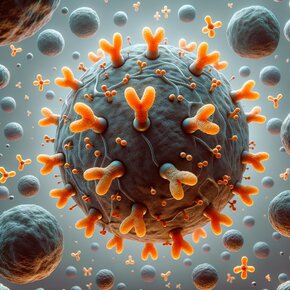Immunoprecipitation
Immunoprecipitation (IP) is a technique used to enrich protein antigens from a complex mixture using specific antibodies. To carry out an IP and allow for purification of the target protein, capture antibodies must be coupled to a solid substrate, such as an agarose resin or magnetic beads.

How Does Immunoprecipitation Work?
Like all immunoassays, immunoprecipitation relies on the recognition of a target protein antigen by a specific antibody. To precipitate the antibody-protein complex out of solution, however, the antibody must be bound to a solid-state material. This can be achieved in one of two ways:
- The antibody can be bound to agarose or magnetic beads that are conjugated to protein A or G and then added to the protein-containing solution.
- Free antibody is added to the target solution, where the antibody-protein complex is formed and then bound to beads.
The subsequent precipitation of the antibody-antigen complex from solution is a function of the type of beads used. If magnetic beads are used, the sample can be placed in a magnetic rack to capture the immunoprecipitate while the unbound proteins are washed away. If agarose beads are used, the sample can be centrifuged to pellet and isolate the protein-bound beads while the supernatant is removed.
After the protein-antibody-bead complex has been isolated, the next step is to elute the bound proteins from the beads. Elution buffers disrupt the antibody-antigen interaction, allowing the target protein to be released. The choice of elution buffer may vary depending on the specific requirements of the experiment and biochemical properties of the target protein, but common options include low pH buffers or buffers containing a high concentration of salt.
Downstream Applications of Immunoprecipitation
Protein Purification
IP is often used as the first step in experiments that require isolating individual proteins or protein-containing complexes. When the goal is to isolate individual proteins, IP can be used for small-scale protein purifications, such as isolating a target protein produced by genetically engineered cells. It can also be used to enrich the concentration of a protein target that is found in low abundance in the primary sample. This approach works best with proteins that do not interact with other proteins.
Proteins immunoprecipitated out of solution can be further analyzed for their molecular weight or post-translational modifications by using techniques such as western blotting or mass spectrometry. SDS-PAGE can be employed to separate the proteins based on their size, followed by western blotting to confirm the presence of the target protein.
Protein Complex Isolation
Protein-protein interactions can be characterized using co-IP or RIME (rapid immunoprecipitation mass spectrometry of endogenous proteins) which use IP followed by western blotting or mass spectrometry to identify characteristics of two or more complexed proteins.
Besides its utility in isolating proteins and protein complexes, techniques including chromatin immunoprecipitation (ChIP), ChIP-seq, and RIP (RNA immunoprecipitation) can be used to map the nucleotide binding capacity of certain proteins in biologic samples. Additionally, IP can play an important role in yeast two-hybrid assays since it can be used as a secondary method to control for the specificity of the technique.
Protocols for Immunoprecipitation
Get the most out of your experiment with our immunoprecipitation protocols: